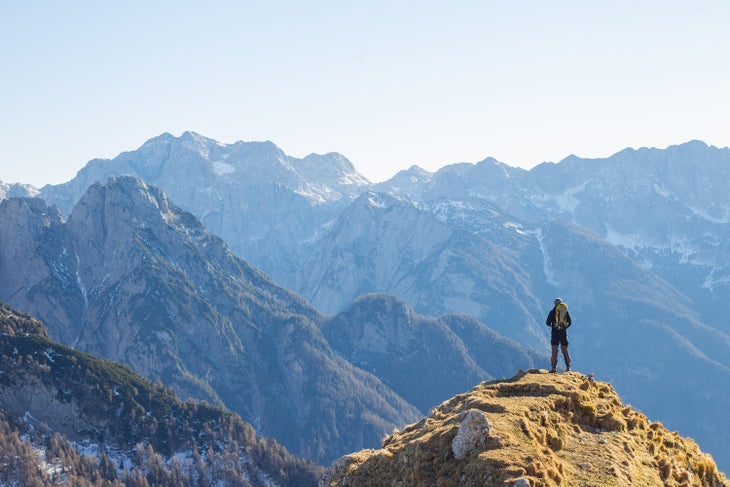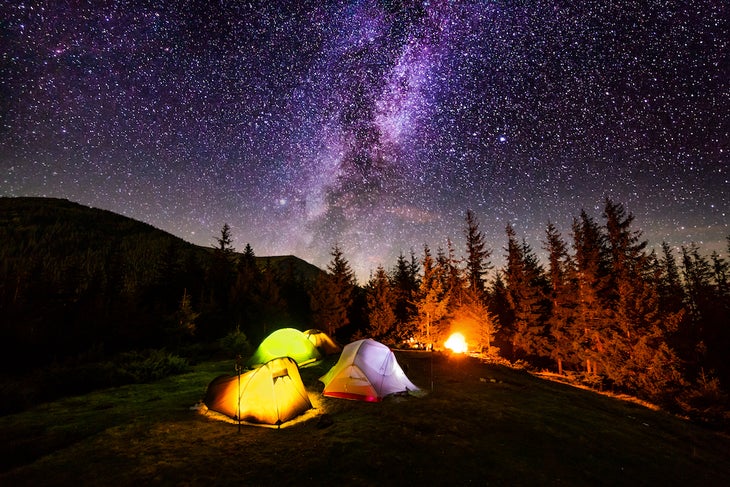Products You May Like
Get full access to Outside Learn, our online education hub featuring in-depth fitness, nutrition, and adventure courses and more than 2,000 instructional videos when you sign up for Outside+
Sign up for Outside+ today.
Alpine views can be breathtaking, but when shallow breaths lead to headaches, dizziness, and nausea, you might not be able to enjoy the vistas as much as you’d like. Going too high too fast is a recipe for acute mountain sickness (AMS, also known as altitude sickness). Even about a quarter of people who go to moderate altitudes of 6,000 to 9,500 feet could feel some symptoms. Up the ante to even higher elevations, and the symptoms become more severe.
Altitude sickness prevention involves taking your time getting up to elevation and caring for your body while you do. What you eat, how often you drink, and where you camp can all affect how you respond to altitude. Below are some expert tips for how to minimize discomfort in the high country.
Strategize Your Diet
Eat Smart
The high-altitude diet: more carbs, less fat. Why? It takes more oxygen to burn fat (for the energy produced) compared to carbs. Backpacking nutrition wisdom holds that you should eat 30 to 60 grams (120 to 240 calories) of carbohydrates per hour to improve strength and endurance and delay fatigue, but there’s no magic ratio. The most important thing for altitude sickness prevention is to get calories on board even if you lose your appetite. If you don’t consume enough carbohydrates, the body will burn muscle protein and stored body fat. A few examples of good carb choices: energy gels or shot blocks, sports drinks, dried fruit, and bars.
Also, add these two ingredients to your backcountry menu:
- Garlic: Sherpas think garlic helps with altitude acclimation, and who’s going to argue with the world’s best high-elevation mountaineers? There’s no proof it works, but science seems to side with the Sherpa: Exposure to high altitude increases red blood cells, which makes the blood thicker. Studies suggest that garlic acts as a blood thinner.
- Beet juice: A study from the Norwegian University of Science and Technology found that nitrates in beetroot juice relax blood vessels, helping to prevent altitude illness. Add a packet of powdered Beet Boost ($30 for 10) to your water for a concentrated dose.
Stay Hydrated
Dehydration worsens altitude illness; it impairs your body’s ability to regulate internal temperature and acidity. Establish a drinking routine and monitor your intake so you stay hydrated even if you’re not thirsty. By the time the thirst response is activated, you’re already 2 to 3 percent dehydrated.
Start your hike hydrated by consuming 14 to 22 ounces of water about 2 hours before exercise. During the hike, drink to thirst: A good goal is to drink 6 to 12 ounces of water or sports drink every 15 to 20 minutes. Recover by drinking 16 to 20 ounces of water or sports drink every hour for a few hours after the hike to fully rehydrate.
Skip Happy Hour
Avoid anything that is a respiratory suppressant, namely alcohol. It exacerbates dehydration, and it doesn’t help that the symptoms of altitude sickness mimic those of a bad hangover. Also, hate to break it to you, but caffeine’s diuretic nature also makes it harder to adjust to high elevations. But, if you’re a habitual coffee drinker, you don’t have to skip your morning cuppa. The effects of caffeine withdrawal are similar to those of altitude sickness, so you could misdiagnose yourself if all you need is a little caffeine.

Plan Your Trip Accordingly
Exercising contributes to altitude sickness (stress hormones are suspected), according to a study published in the Journal of Applied Physiology. On your first day up high, plan for easy hiking, climbing, or rest. If you’re coming from sea level, spend a day or more near 5,000 feet to make your transition to thin air smoother on your body.
Say you hike to 10,000 feet and spend a couple days at that elevation. Your body has now adjusted to 10,000 feet, but if you want to climb to 12,000 feet, you have to acclimatize to the new elevation. In order to adjust to the decreased oxygen in the air, the body produces more oxygen-carrying red blood cells and increases the pressure in pulmonary arteries to encourage blood flow to the lungs. You also naturally start to breathe quicker and take deeper breaths.
When organizing the trip itinerary for your next adventure in the high country, be sure to keep your acclimatization days in mind. Take a couple days to let your body adjust before you hit the trails, and only ascend once everybody in your group has acclimatized. You know you’re ready to climb to higher peaks when you have stayed at elevation for over 24 hours without symptoms of altitude sickness. Take note that these symptoms are usually worse at night.
Hike High, Sleep Low
When feasible, ascend a little higher than your camp during the day. Consider climbing a few hundred feet on a pre-dinner walk. Sleep as low as possible before summit attempts.
Similarly, if you’re above 10,000 feet and you ascend more than 1,000 feet in a day, come down a few hundred feet to sleep. Climbing too high too fast will increase your risk to altitude sickness. Increase campsite altitude no more than 2,000 feet per day. Above 8,000 feet, climb slowly and conservatively, stay hydrated, and be alert for symptoms of AMS.
Get Out of Your Bag
In high, cold conditions, campers tend to spend a lot of time horizontal in a tent, but that works against acclimatization. When you’re lying down, your body increases blood flow to the heart, which in turn increases fluid loss through the kidneys—basically, you pee more. This can make you dehydrated, leaving you more prone to the unpleasant symptoms of altitude sickness. If weather forces you inside, make hot drinks, play cards, write in your journal, and get a normal amount of sleep.

How To Treat Altitude Sickness
If you used all these altitude sickness prevention tips and still feel symptomatic, the best thing you can do is get to lower elevation as safely as possible. It’s important to recognize how severe your case of altitude sickness is, because some cases can be fatal.
Acute Mountain Sickness (AMS): This is most basic, common form of altitude sickness. Typical symptoms here include dizziness, headaches, muscle aches, and nausea. If you feel these symptoms, stop where you are; don’t go any higher for another 24 to 48 hours. You can manage a headache or mild aches with over-the-counter pain relief symptoms. Make sure you’re staying hydrated, too.
High-Altitude Pulmonary Edema (HAPE): This level of altitude sickness includes typical AMS symptoms, plus a cough that starts off dry and can progress one that produces frothy, pink sputum. Also, abnormally labored breathing and chest pain could indicate HAPE. This can be life-threatening if you don’t descend quickly. In fact, until the end of the 19th century, HAPE was misdiagnosed. Reports of young, healthy men dying suddenly after a few days of arriving at high altitude stated that the cause of death was pneumonia.
If any symptoms continue even after descending to lower elevations, go to your doctor.
The expert: Dr. Pete Clark is a physician for the U.S. Ski and Snowboard Association and California’s Mammoth Track Club. He has done altitude sickness research on a grant from the Wilderness Medical Society and is the medical director for Mono County Search and Rescue in California.
